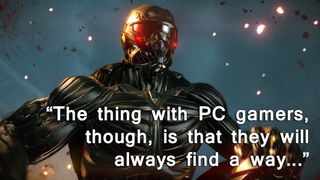Crysis 3 interview

After our live demo of Crysis 3, I had a tight 10 minutes to interview Crytek's Senior Creative Director. Here's what I asked.
PC gamers fell in love with Crysis as a sandbox game. And I think what we're skeptical about with Crysis 3 is, “What's structurally different in terms of the level design?” Not thematically, not aesthetically different, but what's structurally different in Crysis 3 compared to Crysis 2? Is the "urban rainforest" simply buildings wrapped in ivy?
Rasmus Højengaard: No. So... I mean, from a level design point of view, the environment we created is completely different from actually both previous installments of the game. It resonates... I love the games, it resonates New York from Crysis 2 and it resonates the Ling Shan Islands in Crysis one. But it takes that to a completely new level by having this rainforest thing being built by the city, rather than just having rainforest planted on top of the city or in the streets or whatever way you would do it if you did that kind of overgrown city setting.
What that does is, it gives us this great palette of gameplay variants through these seven different rainforest concepts that we have, ranging from an open, broader, much more of a sandbox like you saw in Crysis 2, but also having more condensed, more claustrophobic, maybe, settings, more linear sections with whatever strengths that brings with it. And then we utilize whatever things work best for whatever thing we want to convey, experience we want to convey in the game. You'll see broader gameplay than in Crysis 2, but you'll also see more of the vertical, narrow stuff that Crysis 2 had. Because each approach has merit, and right now we just have a bigger dynamic range than we had in each of the previous games individually, if that makes sense.
And also, the fact that we have this nanodome, having grown this rainforest, we can push what is realistic within a rainforest, because it's an artificially grown environment. We can also completely change the rules for what is valid or not valid within an urban setting. So it's an ability for us to add a kind of... I won't call it fantasy, but pushing perceptions of reality through sci-fi in a way that we couldn't do with the previous games.
It gives you a plot device for doing what you want to do.
RH: Yeah. It's a great catalyst for amazing visuals and environments to play in.
The biggest gaming news, reviews and hardware deals
Keep up to date with the most important stories and the best deals, as picked by the PC Gamer team.
Does Prophet's bow transform into a crossbow?
RH: It's a compound bow. The variety lies in the types of...shall we call them warheads, that you can put on the arrows. I guess in theory we could say that you could, if you wanted to, play the whole game through with all kinds of different strategies only using that weapon. Obviously there's going to be some people who think that's awesome and there's going to be some people who are like, that's boring, I want to play all the weapons. But it's a very diverse weapon. From a style point of view, we just thought it was so almost arrogant to have the most advanced piece of technology, you, using the simplest, most basic old-school type of weapon, the bow. And then at the same time creating the most advanced type of bow we could come up with, so you still kind of fit, while at the same time having a stark contrast between what you would maybe expect Prophet and the Nanosuit soldier to use.
This is left-field observation, but it's an interesting symbolism there with the bow being a native American weapon, and you're sort of a native American yourself, being attacked by aliens...
RH: [laughs] Yeah, you could draw that parallel if you want to.

Are there any new Nanosuit powers other than hacking?
RH: That's the only one we've introduced now. But the hacking one is a really interesting one, you saw a very small snippet of it, it's going to scale through the whole game. The interesting part, just as the ability to shoot Ceph weapons, is that it ties in with the fiction and what you can do as Prophet and your whole journey of self-realization. So we don't want to add arbitrary stuff. We want to add depth to features rather than a lot of different things that don't have any depth.
PR representative: We've probably got time for one more.
Okay. I've been recording for six-and-a-half minutes, are you sure?
PR representative: Oh, go ahead.
Crysis 2 launched with four graphics settings. You could change resolution, you could toggle on Vsync, there was HUD bobbing, and you could change the quality settings. Are you going to launch Crysis 3 with four graphics settings?
RH: We obviously learned a lot from that, which is why we added a lot of stuff with the DX11 pack for Crysis 2. So obviously that's kind of like... You can see that as a starting point. But that being said, all this stuff hasn't been locked down. It's one of these things you do very late in the production, you decide which buttons you want to expose to people.
The thing with PC gamers, though, is that they will always find a way if they're really interested, right? Whether they have to go in and do it directly in the config files, or through a UI, it almost makes no difference. Even if you expose everything in the UI, they'll still go into the config files and see if there's a couple of prototype test render features that haven't been activated yet. But I mean, obviously, if we have the adjustability it makes sense to put it into the frontend so you can adjust it directly. But I can't say exactly what we're going to do. We don't know yet.
Will you do a DX11, or HD texture pack for Crysis 3, as you did post-release for Crysis 2?
RH: Maybe? We probably want to go for making it just native to DirectX 11 as it launches. With whatever that entails. Obviously our reference, starting point, is wherever the CryEngine 3 was when we released the DX11 patch, and then we're building from there. We're working on some pretty badass render stuff now. How much of it and to what extent it will be in the game is going to be hard to say at this point, because a lot of it is very work-in-progress. But even if just half of it makes it, it's going to add a lot of stuff, even on top of the DX11 patch for Crysis 2.
Understood. So, game endings have been a topic of conversation lately. And one of the things I was actually a little dissatisfied with in Crysis 2, that I felt might've been antithetical to the spirit of the game—it ended with a quick-time event. I'm wondering if you regret that at all, and if Crysis 3 will have quick-time events.
RH: Um... Those kinds of particulars... It's still too early to say. We obviously want to push the sense of empowerment, that you do things. In order to capture casual gamers, you need to really figure out where you layer in the complexity and where you choose to just let people kind of go... "I've done this, now I can lean back and see the whole thing unravel in front of my eyes." We learned a lot of stuff from Crysis 1, and we learned a lot of stuff from Crysis 2.
We want to do everything we can to make sure that we leverage the strengths of having the player control everything and do the actual stuff themselves, and also leverage the fact that sometimes it's nice to just be able to actually see what's going on, because you don't have to sit and concentrate on doing five skill-based things at the same time as watching two buildings collapse. Because you'll either screw up the skills or you won't really get the full visual, overwhelming, epic experience.
It's such a bipolar experience, to have done a game only for PC in Crysis 1, and then suddenly having to go multiplatform. Either of those were extreme in their own way, and now we've done both, and now we want to cover all the bases and use all the strengths of that, and then, out of all of that, taking location and gameplay and the whole thing to a completely new level. That's a very convoluted way to answer that question...
So do you think quick-time events—
PR representative: —We gotta cut it.
Okay, okay. Alright.

Evan's a hardcore FPS enthusiast who joined PC Gamer in 2008. After an era spent publishing reviews, news, and cover features, he now oversees editorial operations for PC Gamer worldwide, including setting policy, training, and editing stories written by the wider team. His most-played FPSes are CS:GO, Team Fortress 2, Team Fortress Classic, Rainbow Six Siege, and Arma 2. His first multiplayer FPS was Quake 2, played on serial LAN in his uncle's basement, the ideal conditions for instilling a lifelong fondness for fragging. Evan also leads production of the PC Gaming Show, the annual E3 showcase event dedicated to PC gaming.
Most Popular






